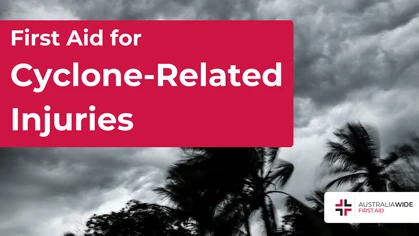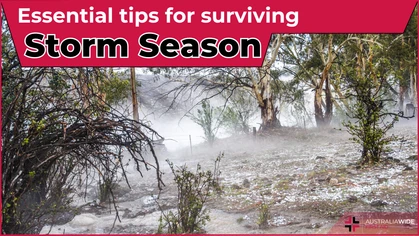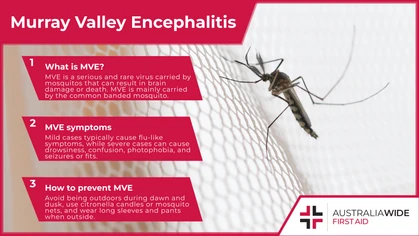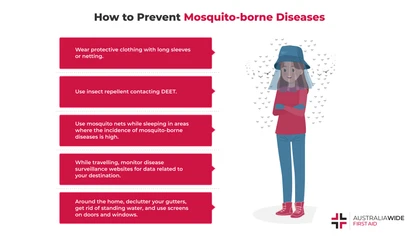Barmah Forest Virus

Seasonal Concerns
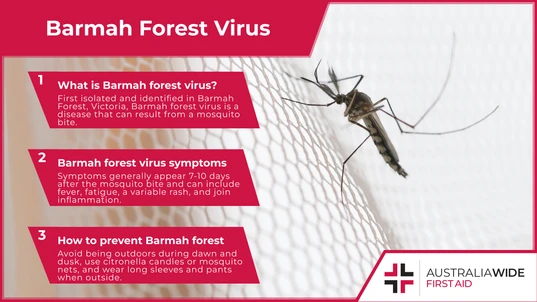
Barmah Forest virus is a mosquito-borne diseases characterised by fatigue, joint pain, and variable rashes, which can persist for several months. The best way to prevent infection by Barmah Forest virus is to protect yourself from mosquito bites.
Increased mosquito activity comes with the wetter and warmer months of summer. Mozzies play a key role in our ecosystem, but can also transmit viruses characterised by long-lasting and debilitating symptoms. Barmah Forest virus is a disease that can result from a mosquito bite. Symptoms of Barmah Forest virus disease include joint inflammation and pain, fever, fatigue and variable rashes around the limbs and the trunk of the body. Most people recover from Barmah Forest Virus within six months. Some people may not even develop symptoms and others may have persistent long-lasting effects. Prevention is better than a cure. As the summer draws in, mosquito bites can be prevented by a few simple tips, meaning you’ll be able to minimise the risk of catching Barmah Forest virus and still continue to enjoy the great outdoors.What is Barmah Forest virus?
Barmah Forest virus was first isolated and identified in Barmah Forest, Victoria in 1974. The four different mosquito species that carry Barmah Forest virus are distributed all over Australia. Various species of kangaroos, koalas, possums, and swamp rats can asymptomatically carry Barmah Forest virus and are believed to be the natural host of the virus. Most of the average 2,400 cases of Barmah Forest virus reported annually each year in Australia are in Queensland. Mosquitos carrying Barmah Forest virus can bite all throughout the year, but cases are increasingly likely during the autumn months of March and April. Barmah Forest Virus is often misdiagnosed as Ross River Fever as they have a very similar set of symptoms.What are the symptoms of Barmah Forest virus?
After being bitten by an infected mosquito, symptoms may occur 7-10 days later. These include joint inflammation and pain, especially in the morning, flu-like symptoms such as fever, aches, chills and fatigue, and a variable rash that can appear on the torso or limbs. While most symptoms of Barmah Forest virus disappear after a couple of weeks, it’s possible symptoms may continue to persist for up to six months and even longer. People who have pre-existing health conditions are at risk of developing long-term health conditions from Barmah Forest virus. Doctors use a blood test to diagnose the presence of Barmah Forest virus in the body. There is no known cure or vaccine for Barmah Forest virus disease. Paracetamol can be used to treat any flu-like symptoms of fever or pain. Always seek your doctor’s advice on treatment and management of your symptoms.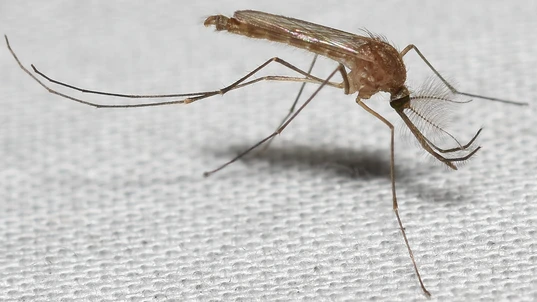
Mosquito-borne diseases occur when an adult female mosquito transmits a pathogen, whether that be a virus or parasite, from one vertebrate host (either animal or human) to another.
What are mosquito-borne diseases?
A mosquito-borne disease, (or a vector-borne disease) is a virus transferred to humans via a mosquito. Barmah Forest virus is believed to be a natural host in some species of kangaroos, koalas, and possums. If a mosquito bites an animal carrying this virus, the virus is transferred to the mosquito, replicated within it and then passed on. A bite from an infected mosquito can result in Barmah Forest virus disease. Mosquito-borne diseases kill more than a million people over the world each year and are found in humid, wet, and warm tropical environments around the world. Examples of more serious forms of mosquito-borne diseases are malaria, yellow fever, dengue fever, and encephalitis (inflammation of the brain). In Australia, the prevalence of mosquito-borne diseases is growing due to urbanisation and climate change. In periods of increased rainfall, mosquito-borne diseases increasingly become an important safety concern.How to prevent Barmah Forest virus?
As mosquito bites can be both uncomfortable and painful, they can also cause allergic reactions in the way of anaphylaxis. Preventing Barmah Forest virus means lowering your risk to a mosquito bite. Here are some simple ways of protecting yourself and your home from mosquito-borne diseases such as Barmah Forest virus:- Avoid being outdoors during times when mosquitoes are most active (dawn and dusk).
- Wear long sleeves and pants when you go outside, as mosquitoes can bite through clothes.
- Use citronella candles or mosquito nets for added protection.
- Use repellent every time you go outside. The best mosquito repellents contain DEET, picaridin, or oil of lemon eucalyptus.
- Use screens on doors and windows around your home.
- Get rid of standing water around your home (mosquitoes lay their eggs in water).
- Keep gutters clean and free of debris.
How to treat mosquito bites?
A mosquito bite is a red, itchy bump that appears when a mosquito punctures your skin in order to feed on your blood. Mosquitoes are attracted to the carbon dioxide that you exhale, as well as body heat and certain chemicals in your sweat. If you do get bitten by a mosquito, the best way to relieve the itch is to apply a cold compress or calamine lotion. You can also take an antihistamine to reduce swelling and itching. If you have a severe allergic reaction to a mosquito bite, you should seek immediate medical attention.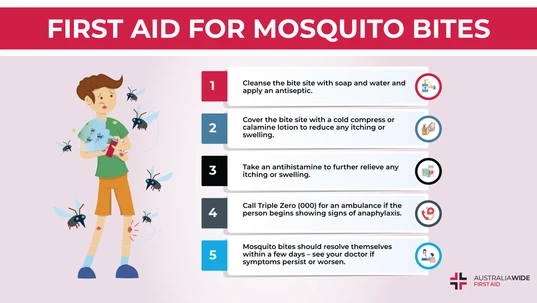
Mosquito bites usually go away on their own within a few days. However, you can aid the recovery process by cleansing the bite site and covering it with a cold compress or calamine lotion.
Mosquito bite first aid
In an emergency, mosquito bite first aid consists of the following steps:- Remove the person from the area where they were bitten as soon as possible.
- Wash the bite site with soap and water, and apply an antiseptic.
- Apply a cold compress or calamine lotion to the bite site to help reduce local pain and swelling.
- Take an antihistamine to relieve the swelling and itching. These medicines should be readily stocked in your DIY first aid kit.
- Resist the urge to scratch the bite site, as this may cause a blister, welt, or infection.
- If the person begins showing signs of an allergic reaction, call Triple Zero (000) for an ambulance, consult the Australian Resuscitation Council's anaphylaxis treatment guideline, and follow DRSABCD and be prepared to perform CPR.
- Mosquito bites usually go away on their own within a few days, but see a doctor if the bite does not improve or if you develop any other symptoms.
Final thoughts
Barmah Forest virus is a mosquito-borne disease that causes joint inflammation and pain, fever, aches, chills, fatigue and a rash. Preventing mosquito bites is the best way to avoid catching Barmah Forest virus. Wearing long-sleeves, using mosquito repellent, and keeping your home clear of any ideal mosquito breeding habitats (still standing water or debris in gutters) are a few effective ways of protecting yourself from mosquito bites. To learn more about mosquito bite first aid and mosquito-borne illnesses, book a first aid course with us today.References
- National Center for Biotechnology Information: Mosquito-Borne Viruses and Non-Human Vertebrates in Australia: A Review
- The Interpreter: What climate change means for mosquito-borne diseases
Originally published at
https://www.australiawidefirstaid.com.au/resources/barmah-forest-virus
as part of the Australia Wide First Aid Articles Library
